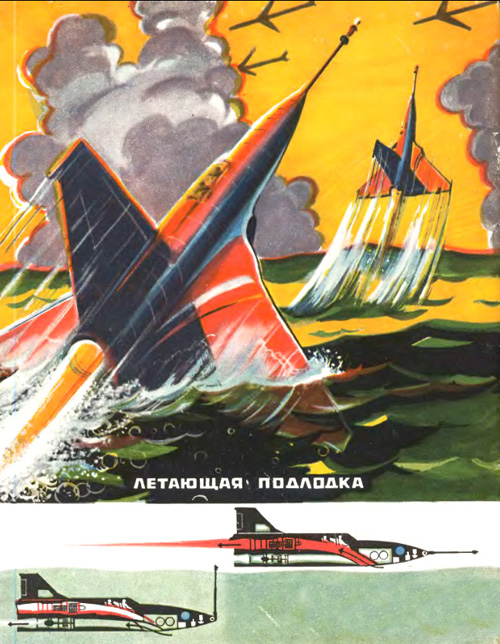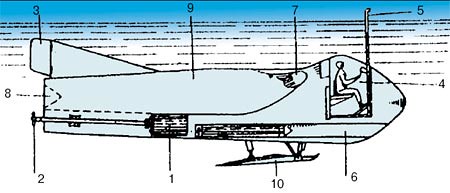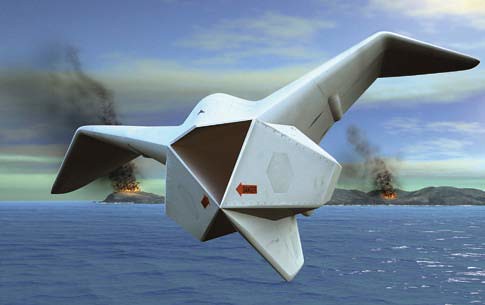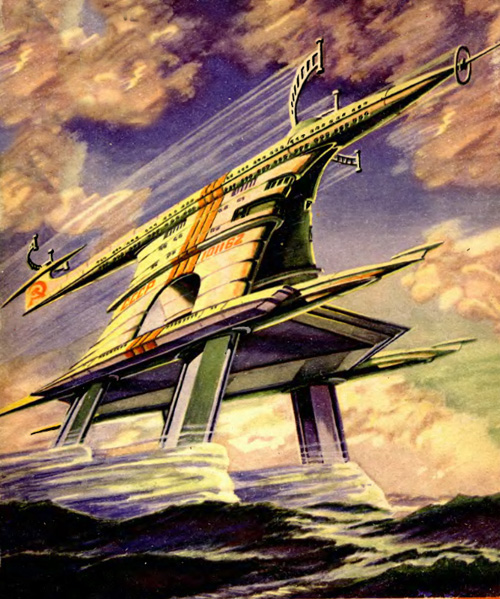There is nothing like the look of abject horror on the face of your players in a post apocalypse game like the moment when they realize that the opposition has better toys then they do. This is especially true of groups like the old edition Gamma World 'Knights of Genetic Purity'
Pulp Science Fiction is filled with strange & twisted technology that you can use. Heck the Fallout video games built a solid reputation on ' appropriation' of these types of tech. Could you as a Dungeon Master do any less.
The most recent examples of the underwater plane bit was in Sky Captain & The World of Tomorrow. There are however dozens of examples of this type of technology in pulp era books like G-8 & his Battle Aces 1933 -1944 Here or Dusty Ayres & His Battle Birds. 1934-35 Here
The latest incarnation of this technology has been Sky Captain & its themes of genetic engineering & strange mad pulp science. These things seem to go hand in hand. I've used Sky Captain's physiology in post apocalypse game more then once.
The original Story found right here at Dark Roasted Blend Here
Sky Captain's dream come true
Remember Franky's (Angelina Jolie) amphibious attack squadron from "Sky Captain: World of Tomorrow"? The idea of "fighter plane/submersible" combination has a long history in inventor's patents and the actual military research. It's not just "pulp fiction", but rather a fascinating account of the concept that US Navy is now getting ready to turn into reality.

(Artist's take on "Commander-2" successful testing in 1964)
Wild Soviet project, developed before World War II
It all started with a ground-breaking research by B. P. Ushakov, conducted by the Russian military in utter secrecy, between 1934 and 1938. The design never achieved a prototype stage, but was seriously considered for military application: the plane could fly 800 km at the speed of 200 km/h and could dive to 50 meters, having underwater speed of 3 knots.

(image credit: V. E. Bulba)

There's been some inventor activity across the ocean, as well. In 1945, the American inventor Houston Harrington filed a patent for "combination of airplane and submarine":

(image credit: Adventure Lounge)
The "submersible /airship" combination was an attractive idea for the military during World War II. The Japanese used small ("midget") submarines in combination with their air attack on Pearl Harbor. The Italians attacked British battleships in the Mediterranean harbor of Alexandria from the air and their "midget" submarines shortly thereafter. Even if relatively successful, these were suicide missions - but a compact flying sub could fulfill the task and bring their crew back home.
"It could fly from a favorable location to its destination at minimum altitude to avoid detection by radar. At the completion of its underwater mission it could travel as a submersible to a location best suited for takeoff, become airborne and return to base"(The Wilmington Morning News, 1964)
US Navy was playing with the idea in the 50s and 60s, coming quite close to actually making a prototype:
US Patent 2720367 from 1956 was even equipped with torpedoes:


(image credit: AP Wire)
Convair Division of General Dynamics Corp. received a Navy contract to test the feasibility of such a craft. The plane would be submerged by flooding of the wing, tail and hull compartments. It would travel 5 miles an hour under water, powered by batteries.
Don Reid's "Commander-1" actually was submerging and flying, in 1964
Don Reid, an electronics engineer, and independent defense contractor built "Commander-1" prototype, and then "Commander-2" which actually flew and was fully operational. First tests happened in 1964, with the speed of 4 knots while 2 meters underwater. Here is a technical split view, printed in the "Popular Mechanics"-like Russian magazine in 1965: (click to enlarge)


The story of this plane is told in "The Flying Submarine: The Story of the Invention of the Reid Flying Submarine, RFS-1," published in 2004 by Heritage Books Inc.
"The Cormorant" - modern take on the same idea
Today, the "flying sub" concept is very much alive, and even being considered by such heavy-weights as Lockheed Martin's Skunk Works (developers of the U-2 and Blackbird spy planes). This article details plans for an airplane that "starts and ends its mission 150 feet underwater"

(image credit: John MacNeil)
This gull-wing spy plane will operate in a fully stealth mode and will be launched from the Trident missile tubes of some huge nuclear sub. The logistics of launch and retrieval provide for the sub's secretive maneuvers, so that her location will not be given away. Once out of the water, the plane's rocket boosters fire and the Cormorant takes off. At the end of the mission, it's fetched by the robotic unit back into the submarine, deep underwater.
The dream of flying under the water and in the clouds is a noble one, and we'd like to see it fulfilled, not only for the military, but as a new and exciting future means of transportation. Just like the old military ekranoplans can one day serve as a step toward the beautiful "ground-effect" ocean liners.

Thanks for the info!
ReplyDeleteThere will be more to come Trey! I'm working on some Mutant Future/Labyrinth Lord stuff as well speak for an upcoming entry!
ReplyDelete